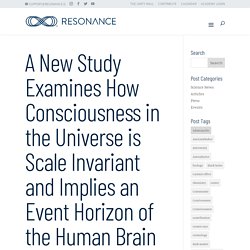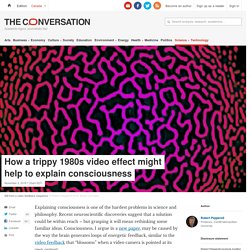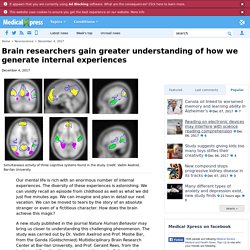

The Weirdness of Our Dreams Could Explain Their Function, Suggests New Theory. Falling from a great height, naked public speaking and simultaneously losing all your teeth.

The content of our dreams is often quite weird. While extensive research has teased out some of the likely reasons why we sleep, why this ubiquitous activity should be peppered with strange and nonsensical imagery has remained mysterious. Now, a new theory that takes inspiration from artificial intelligence has suggested that the weirdness of dreams is essential to their purpose.The theory appears in an article authored by Tufts University Research Assistant Professor and novelist Erik Hoel, published May 14 in the journal Patterns. From Freud to AI In the 120 or so years since Sigmund Freud released his influential tome on dreaming, Die Traumdeutung (The Interpretation of Dreams), neuroscience has replaced his outlandish Oedipal theories with several other proposals for dreaming.
The overfitted brain. Neural network reconstructs human thoughts from brain waves in real time. Researchers from Russian corporation Neurobotics and the Moscow Institute of Physics and Technology have found a way to visualize a person's brain activity as actual images mimicking what they observe in real time.

This will enable new post-stroke rehabilitation devices controlled by brain signals. The team published its research as a preprint on bioRxiv and posted a video online showing their "mind-reading" system at work. To develop devices controlled by the brain and methods for cognitive disorder treatment and post-stroke rehabilitation, neurobiologists need to understand how the brain encodes information. How memories form and fade. Summary: Stable memories are encoded by teams of neurons firing in synchrony, providing redundancy that enables the memory to persist over time.

Source: CalTech Why is it that you can remember the name of your childhood best friend that you haven’t seen in years yet easily forget the name of a person you just met a moment ago? In other words, why are some memories stable over decades, while others fade within minutes? Using mouse models, Caltech researchers have now determined that strong, stable memories are encoded by “teams” of neurons all firing in synchrony, providing redundancy that enables these memories to persist over time. The research has implications for understanding how memory might be affected after brain damage, such as by strokes or Alzheimer’s disease. A New Study Examines How Consciousness in the Universe is Scale Invariant and Implies an Event Horizon of the Human Brain - Resonance Science Foundation.
A paper recently published in the Journal of NeuroQuantology presents a unitary holofractogramic model that is redefining scientists’ view of the physics of consciousness and the seamless interplay of information dynamics from the most fundamental levels of the universe to the living system and the cosmos as a whole.

Major breakthroughs in the study of the physics of consciousness—and information dynamics in general—are occurring through the discovery and elucidation of holographic and fractal principles underlying fundamental properties of nature. For instance, in a fractal organization the degree of complexity of a system is scale-free, or invariant under any translation of magnitude. This means that one can “zoom in” or “zoom out” forever and the same degree of complexity will be observed—patterns of patterns reiterate ad infinitum. The authors of the paper—Dr.
Meijer, professor emeritus at the University of Groningen; and Dr. New Theory: Consciousness Doesn’t Reside In The Brain Or Same Dimension. The Facts:A new analysis of the double slit experiment shows, according to the author, "remarkable" results when it comes to analyzing the mind-matter interaction problem.Reflect On:Why has most of this science been studied by the Department of Defense?

Why are real life, documented and recorded examples never used in these studies? Why is the statistical significance of parapsychology never mentioned? Does mind influence matter? The answer is an unquestionable yes, this fact is firmly established in scientific literature, and the only thing up for debate is just how much of an effect our minds can have on matter. Your morals and religious beliefs are linked. But not in the way you'd expect. Most religious people think their morality comes from their religion.

And deeply religious people often wonder how atheists can have any morality at all. I’m going to use Christianity as my example, not because it’s representative of religion in general, but because there’s a lot of research on Christians, and because many readers will likely be familiar with it. How a trippy 1980s video effect might help to explain consciousness. Explaining consciousness is one of the hardest problems in science and philosophy.

Recent neuroscientific discoveries suggest that a solution could be within reach – but grasping it will mean rethinking some familiar ideas. Consciousness, I argue in a new paper, may be caused by the way the brain generates loops of energetic feedback, similar to the video feedback that “blossoms” when a video camera is pointed at its own output. I first saw video feedback in the late 1980s and was instantly entranced. Someone plugged the signal from a clunky video camera into a TV and pointed the lens at the screen, creating a grainy spiralling tunnel. The Biological Roots of Intelligence. Science is getting closer to understanding what goes on inside the mind when we dream. Dreams are so strange and carry so much significance to us that we often feel the need to tell people about our nocturnal adventures, sometimes at tedious length.

But if you understand what goes on inside the brain as dreams take their course, they start to make a lot more sense. And dreams are much more important than you might think. Here are some common questions answered about the nighttime hallucinations we call dreams. As above so below: Scientists have found a multidimensional universe inside our brain. A sensational discovery has been made by experts as scientists have found that the human brain is home to structures and shapes that have up to 11 dimensions.

Neuroscientists welcome the discovery saying: “We found a world that we had never imagined.” Mathematical methods of algebraic topology have helped researchers find structures and multidimensional geometric spaces in brain networks. According to experts, a new study has proven that the human brain is home to structures and shapes that have up to 11 dimensions. Human brains are estimated to be home to a staggering 86 billion neurons, with several connections from each cell webbing in every possible direction, forming a super-vast cellular network that SOMEHOW makes us capable of thought and consciousness, reports Science Alert.
Brain researchers gain greater understanding of how we generate internal experiences. Our mental life is rich with an enormous number of internal experiences.

If You Get Chills When Listening To Music, It Could Be A Sign You’re Special. Have you ever been listening to a song when all of a sudden, your heart skips a beat, the hairs on the backs of your arms stand up, and a piece of you feels as if it has taken flight? If so, you’re not alone. However, according to a new study, individuals who get “chills” when listening to beautiful music are biologically different.
If Listening To Music Gives You Chills You May Have A Unique Brain. Do you ever hear a drum beat, a harmony, or a tweak of a guitar string that makes a pleasant chill run up your spine? Well, in that case, you may have a special brain. Alissa Der Sarkissian, a research assistant at the University of Southern California's (USC) Brain and Creativity Institute, noticed this strange feeling when listening to the song “Nude” by Radiohead. “I sort of feel that my breathing is going with the song, my heart is beating slower and I’m feeling just more aware of the song — both the emotions of the song and my body’s response to it,” she explained.
Neuroscience Discovers That Your Brain Can Literally Be on the Same Wavelength as Someone Else's - Ideapod. I’m sure we’ve all felt that we’ve “clicked” with someone or were on the same “wave length”. Our everyday language is full of these kind of expressions, but is it just a manner of speaking? Not quite, according to Princeton University neuroscientist Uri Hasson. Growing Up Without Siblings May Affect Your Brain's Development. A study in China claims that growing up without siblings can lead to a different brain structure than those who do. They found that only children tended to be more creative and less sociable. Previous studies have focused on the difference in behaviors, cognitive function, and personality traits between only children and those with siblings. After all, it’s common sense that those without siblings don’t have to share their parents’ attention, and so likely get more encouragement, but miss out on the early experience of sharing, or competing.
This new study, by the Southwest University in Chongqing, and published in Brain Imaging and Behavior, wanted to find out if the difference in behaviors had a neural basis. Anil Seth: Your brain hallucinates your conscious reality. Cookies are Not Accepted - New York Times. Project to map human brain from womb to birth releases stunning images. A landmark project to map the wiring of the human brain from womb to birth has released thousands of images that will help scientists unravel how conditions such as autism, cerebral palsy and attention deficit disorders arise in the brain. The first tranche of images come from 40 newborn babies who were scanned in their sleep to produce stunning high-resolution pictures of early brain anatomy and the intricate neural wiring that ferries some of the earliest signals around the organ. The initial batch of brain scans are intended to give researchers a first chance to analyse the data and provide feedback to the senior scientists at King’s College London, Oxford University and Imperial College London who are leading the Developing Human Connectome Project, which is funded by €15m (£12.5m) from the EU.
Hundreds of thousands more images will be released in the coming months and years. Being on the same wavelength isn't just a figure of speech. It's proven neuroscience. — Quartz. Physicist Richard Feynman returned over and over to an idea that drove his groundbreaking discoveries. Study uncovers how brain damage increases religious fundamentalism. Research has found religious belief is associated with certain regions of the human brain, but there is still much to learn about how these areas influence religious belief. Neuroscientists Discover a Song That Reduces Anxiety By 65 Percent (Listen) Anxiety — that feeling of dread, fear, worry and panic — is certainly nothing new.
Scientists Surprised to Find No Two Neurons Are Genetically Alike. The past few decades have seen intensive efforts to find the genetic roots of neurological disorders, from schizophrenia to autism. Neuroscience. After watching this, your brain will not be the same. Your Brain Has A DELETE Button And Here's How To Use It! There’s an old saying in neuroscience: “neurons that fire together wire together.” This means the more you run a neuro-circuit in your brain, the stronger that circuit becomes. This is why, to quote another old saw, “practice makes perfect”. The more you practice piano, or speaking a language, or juggling, the stronger those circuits get.
Scientists have known this for years. Man Missing Most Of His Brain Challenges Everything We Thought We Knew About Consciousness. Yet miraculously, the man was not only fully conscious, but lived a rich and unhindered life, working as a civil servant and living with his wife and two kids, blissfully unaware of the gaping hole in his brain. His ability to function without so many of the key brain regions previously considered vital for consciousness raises some major questions about existing theories regarding how the brain works and the mechanisms underlying our awareness. Empathy for others’ pain rooted in cognition rather than sensation, CU-Boulder study finds. The ability to understand and empathize with others’ pain is grounded in cognitive neural processes rather than sensory ones, according to the results of a new study led by University of Colorado Boulder researchers. Artists 'have structurally different brains'
17 April 2014Last updated at 05:35 ET By Melissa Hogenboom Science reporter, BBC Radio Science. MCB80x Course Intro: The Complex Species. The Fundamentals of Neuroscience: Nervous System Basics. Mcb80x. What percentage of your brain do you use? - Richard E. Cytowic. Reconstructing visual experiences from brain activity evoked by natural movies - GallantLabUCB. Neurophenomenology.com. Kvinnors och mäns hjärnor olika kopplade. Brain Stimulation May Induce the Human Will to Persevere - Wired Science.
The salience network, highlighted here in two epilepsy patients, is thought to mediate our response to important internal or external signals, such as pain or the sound of a siren. Image: Parvizi et al. 'Memories' pass between generations. A Neuroscientist's Radical Theory of How Networks Become Conscious - Wired Science.
What percentage of your brain do you use? - Richard E. Cytowic.